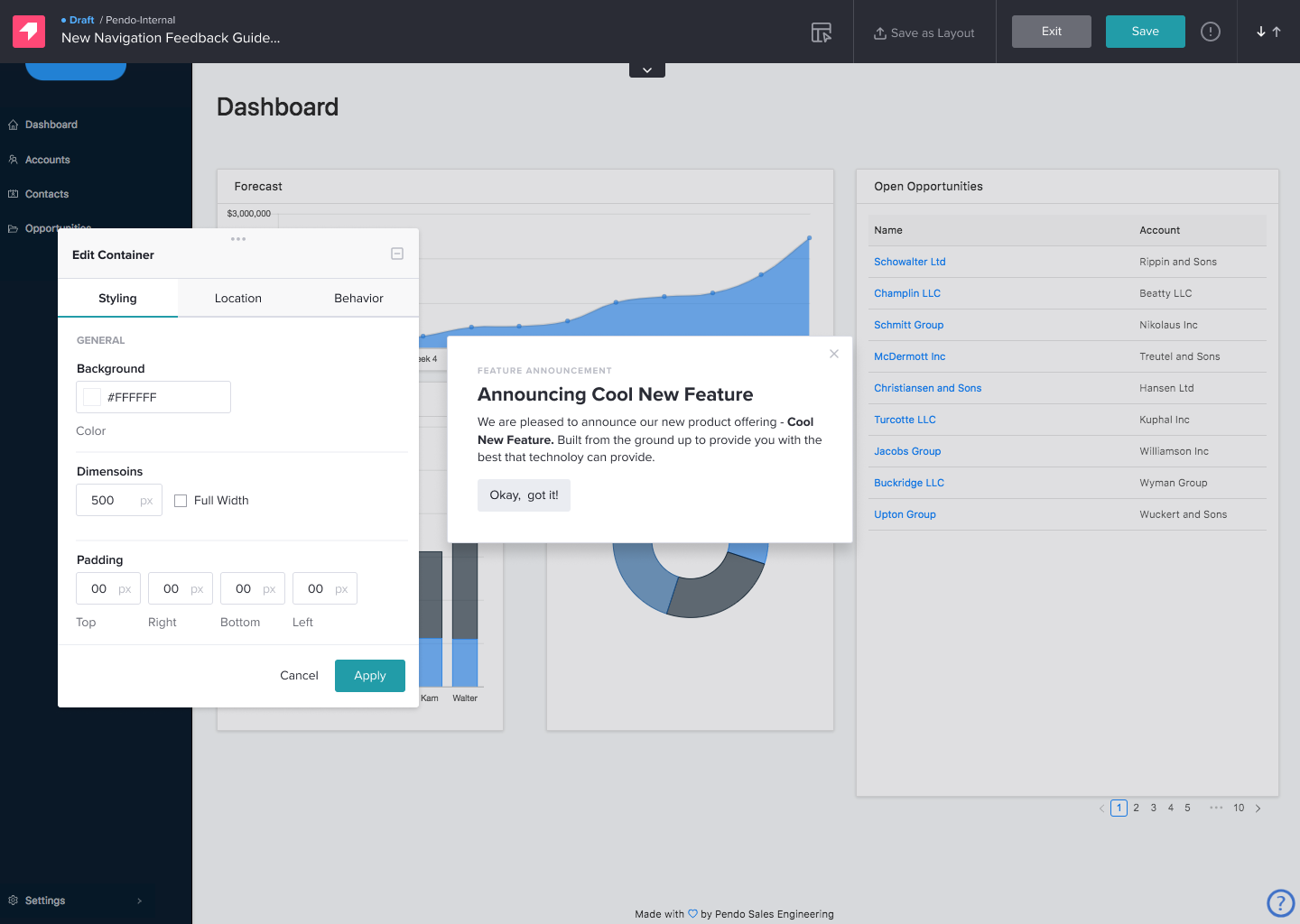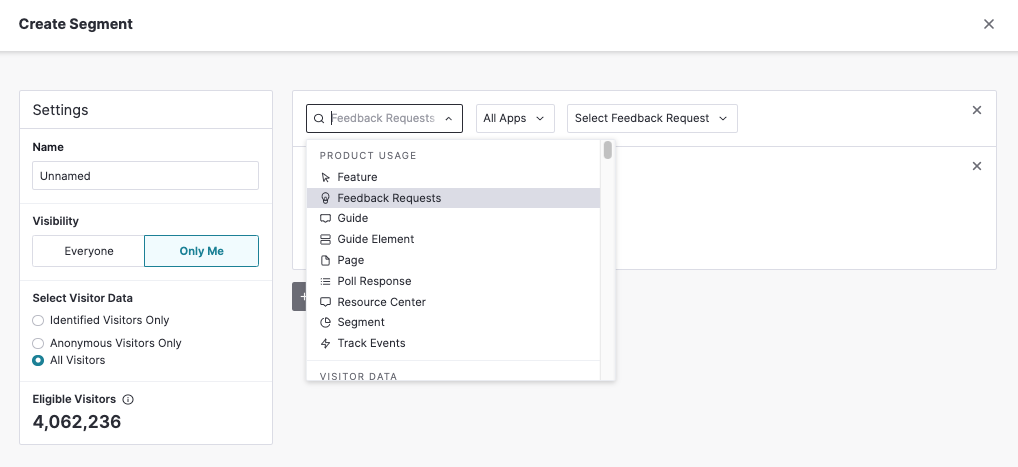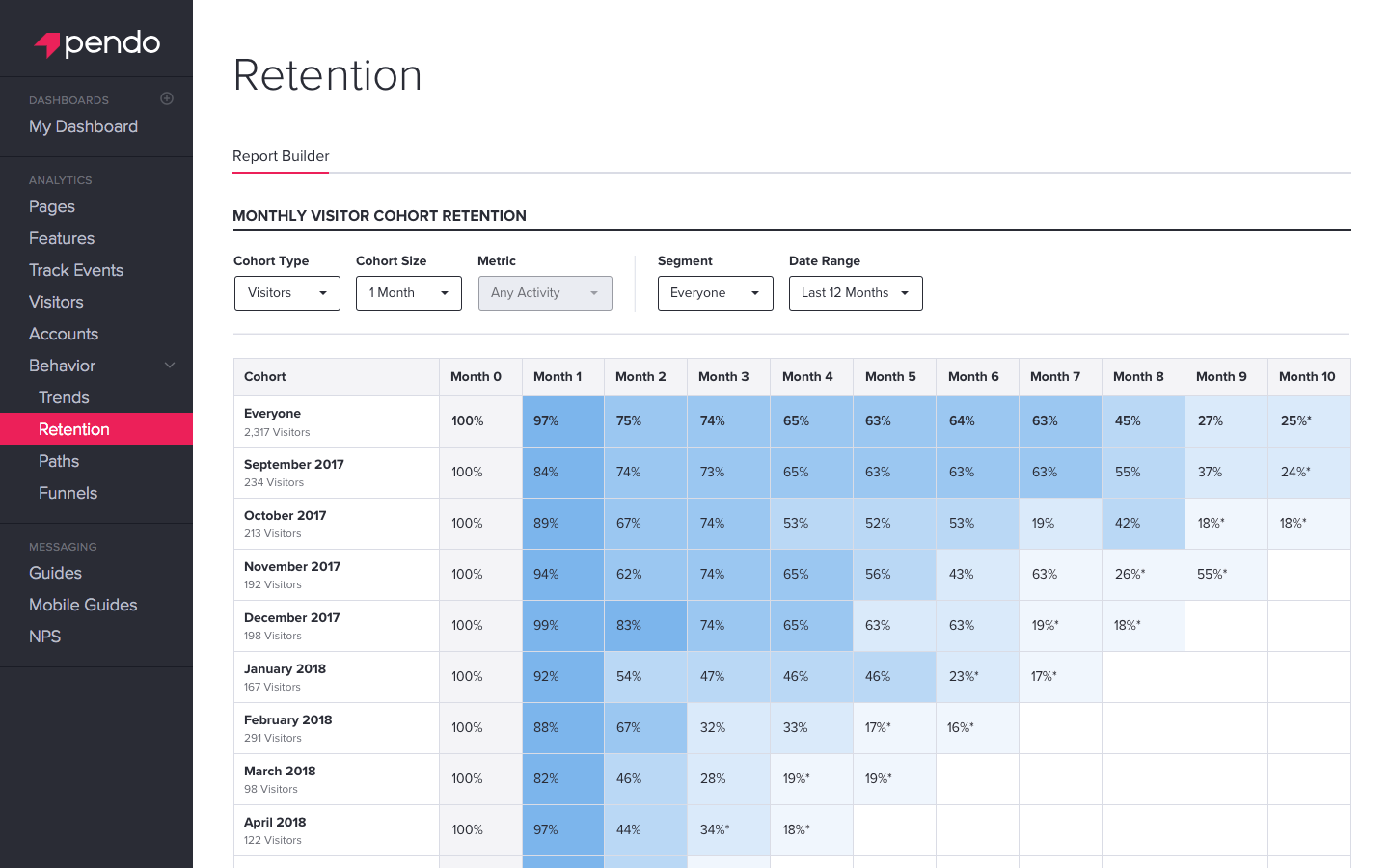Pendo vs Appcues: 2025 Best User Onboarding Platform

Pendo vs Appcues: 2025 Best User Onboarding Platform
Key Takeaways
Customization and Flexibility: Pendo offers deeper customization options, especially with built-in analytics, while Appcues focuses on a no-code, user-friendly setup that makes it easier to create onboarding flows without technical skills.
Ease of Use vs. Advanced Features: Appcues is ideal for teams seeking a quick, no-fuss onboarding tool, while Pendo provides advanced features for teams needing detailed insights and analytics.
Mobile and Desktop Solutions: Pendo provides more robust mobile onboarding options with advanced tracking, whereas Appcues primarily focuses on desktop experiences.
Pricing: Pendo and Appcues both operate on higher pricing tiers, with Appcues starting at $299/month and Pendo offering flexible plans based on your usage and needs. For a more cost-effective alternative, Hopscotch starts at just $99/month, offering a great mix of features without the steep cost. Explore Hopscotch pricing and see how you can save without sacrificing functionality.
Pendo and Appcues are two of the leading user onboarding software tools.
User onboarding software tools make it easy to create no-code, customized tours for users as they first begin using your product.
But great tools like Pendo and Appcues don't stop there. They also feature:
Super finely-tuned targeting for tours
Deep user analytics
Customer surveys
One product has mobile (iOS/Android) user adoption
And one even has employee onboarding features (if you need that)

Both tools are great. But they definitely differ in a few key ways, including price and customer support.
So if you want to reduce your churn, increase retention, and foster better user onboarding, keep reading!

Why Try a User Onboarding Software?
You work hard on making sure every product you offer is exceptional, but no matter how intuitive your design is, you still need a scalable onboarding process. According to Wyzowl, 63% of users consider a company’s user onboarding process before buying the product.
Improving user onboarding is one of the most tried and true ways to reduce SaaS churn and increase the likelihood that a casual user becomes a power-user.
So, what exactly is a user onboarding tool?
In short, a user onboarding software is any tool or collection of tools that acts as a guide to help your customer navigate the different features of your product. User onboarding systems can also help you get valuable analytics and feedback as you continue to introduce a new product.
Pendo and Appcues are two of the best user onboarding tools on the market.
Let's dig in!
📚 Also read: 11+ SaaS Growth Hacks You Need to Know (If You Don't Already)
📚 Also read: Appcues vs. Chameleon
📚 Also read: The 12 Best SaaS Onboarding Solutions
1. Appcues

Appcues makes it simple to create, deploy, and onboard users for your product in minutes without writing a single line of code. You can use Appcues to welcome new users and show old users new features by walking them through your app or product. Appcues is a no-code onboarding tool. In it, you design targeted onboarding flows with custom and pre-made templates to suit the color and brand of your business.
Features of Appcues
Appcues is a fantastic tool for communicating to current users of your product about updates, upcoming features, and more. Some unique features of Appcues include the following:
User Onboarding: This is the prominent feature of Appcues; you can create outstanding first impressions in seconds or minutes, and you can set up new users for success by tailoring onboarding experiences to users at the right time. You can join thousands of product creators using Appcues to offer individualized-looking onboarding experiences that engage your product users.

Feature Adoption: This is the most valuable feature you can use by signing up for Appcues. You have a great mission with your product, so don’t let any of your product features go unnoticed. You can create in-app show-throughs to familiarize new users with essential features. Appcues provide tested and proven templates to simplify feature adoption. For example, Litmus, one of the famous email marketing platforms, used this feature to increase its feature adoption by 2,100%. Satisfy your curiosity here.
Appcues Builder: Our review of Appcues will not be complete without mentioning the builder, which has over 20,000 users and a 5-star rating on the chrome web store. Appcues builder is a chrome extension that gives you the power to create flows and track events on the go. It powers you to use Appcues on top of your product and create something stunning- this can wow your users and blink their eyes. Appcues Builder is a no-code builder you can use to drag and drop images, change texts, and reposition buttons to make everything under your control. The builder makes your work fun.

Appcues Studio: When you sign up and log into Appcues, you’ll land on the Studio, an environment where you can create flows and segment your users. The Studio enables you to upload typography, colors, logos, brand attributes, buttons, and illustrations.
Appcues Insights: Insights is a new feature added to the toolset of Appcues. It allows you to analyze and see how users interact with your product. Understanding user behavior is essential, and that’s why Appcues Insights comes in; you get to see crucial things like onboarding reports, new ser signup reports, click on “get demo” reports, and payment method added reports.
Other Features: Besides the features above, you can use Appcues surveys to gather information on features users would like you to add to your product. A better way to take surveys is when users are in your product, known as in-app surveys. In addition, you can inform users about updates and new features and announce events or webinars. I love Appcues' audience segment triggers.

Pros of Using Appcues
Drag-and-drop builder and on-brand assets make sure your in-app widgets look great
90 days of onboarding support for Growth plans and above
Flow variation AB testing
Now supports mobile apps as well
Cons of Using Appcues
It’s challenging to analyze data and see stages where users drop off with Appcues
Appcues gates is "highest tier" integrations like Zendesk and Zapier, forcing you to go to a higher plan if you want those integrations
You may find it difficult to segment your audience sometimes
Integrations of Appcues
Appcues integrates with most tools from email marketing to data analytics, including:
Salesforce
Marketo
HubSpot
Slack
Zendesk Sell
Zendesk Support, and
All-in-one Zapier integration
Customers of Appcues
Appcues is a reliable and trusted partner helping many businesses, from online small businesses to large enterprises, hit their goals. Popular customers include:
GetResponse
Litmus, one of the best email tools
Plural Sight
Hotjar
GoToWebinar
Pricing of Appcues
Appcues provides solutions to its customers through three different pricing:
Essentials: $299/month or $249/month/annual for up to 2,500 monthly active users. Ideal for small businesses and startups.
Growth: $879/month starting at 2,500 monthly active users. You get everything in the essential plan in addition to fantastic features. Ideal for teams at high-growth companies.
Enterprise: contact sales for custom pricing. Ideal for multiple products or enterprises.
Bottom Line
Appcues is suitable for educating users with workflows in your product. It has apparent features to guide users throughout the customer journey. Your product users can pick up where they left off if necessary. Appcues has 4.6 stars on G2.
👉 Looking for something a bit more affordable? Try Hopscotch (no credit card required).
2. Pendo

Pendo has been focused on product analytics since the beginning. In fact, it's one of the original no-code analytics (along with Heap). With Pendo, you drop one pixel on your site and you can slice and dice data any which way you like. Are you curious to know where users drop off in your onboarding funnel? Pendo can help. If you're trying to figure out how many times the average user logs in per day -- Pendo can help. But Pendo also has super sophisticated product onboarding tours and surveys like Appcues. It does both analytics and product tours extremely well with just a single line of code.
Features of Pendo
Pendo is perfect for large organizations that have deep analytics and user onboarding needs. It has all the customary stuff like user engagement, user feedback, and great integrations, but it also has the most advanced in-app analytics features out there:
User Onboarding: Like Appcues, Pendo can create product tours with extreme segmentation -- so you can show users the right tour at the right time. Pendo enables teams to make pixel-perfect tours that can display as tooltips, popups, guides, modals, and more. Plus, you can push tours live on your web app and mobile app from one place (if you have a mobile app).

Pendo Tour Builder: As with any product onboarding software, most of the work is done within the no-code builder. Pendo's builder is very slick. It's similar in functionality and "feel" to Appcues' builder. There are also a number of super helpful templates to get you started. So for that reason, I give the Pendo builder a slight leg up.

Advanced Conditions: Because Pendo's biggest strength is analytics, the conditions with which you can target users is pretty magical. You can target any element in your app and just about any segment. You can even segment users based on feedback you've collected from user feedback modals.

Analytics: Pendo's biggest strength lies in its no-code approach to data. Like Mixpanel or Heap, Pendo enables you to drop a little code on your site and get complete universal analytics of your product. And the analytics is retroactive -- so you don't even need to "define" goals. As long as the code is properly placed in your app, you can retroactively answer any analytics-related question. Pendo really does drive ongoing improvement. You can track the progress of your users along the mapped user journey within and between the different user segments. You can see when users reach important milestones and you can nudge them into the direction of those milestones.

Other Features: Pendo includes A/B testing, a feature called Roadmaps which functions as sort of a project management tool. Integrations include Zapier, Salesforce, Intercom, Segment, Zendesk, and many more.
📚 Read more: The Full 9 Step Customer Onboarding Framework and Checklist
📚 Read more: The 16 Best Examples of Interactive Product Tours
📚 Read more: Ultimate Guide to Product-Led Growth with 9+ Examples
Pros of Using Pendo
Drag-and-drop product tour builder
Advanced analytics and user targeting
Flow variation A/B testing
Works on mobile apps too
Cons of Using Pendo
It can get a little complicated to use, given how sophisticated the analytics are -- so there is a learning curve
Price
Integrations of Pendo
Pendo integrates with analytics tools and CRMs:
Google Analytics
Intercom
Segment
Zendesk
HubSpot
Zapier
Customers of Pendo
Pendo works with primarily enterprise businesses, including:
Okta
Salesforce
Labcorp
Verizon
iRobot
Pricing of Pendo
Starter: $7,000/year for up to 2,000 monthly active users
For all other plans, Pendo forces you to book a demo
Bottom Line
Pendo is an insanely powerful tool. Of all the product onboarding tools, it has the best analytics suite. So if you're an enterprise company, it might be a perfect tool for you. The price is prohibitively expensive for most. Pendo has 4.4 stars on G2.
How To Choose Your Best User Onboarding Tool
It will help if you consider a few different factors before selecting a user onboarding tool for your business. Briefly, here are some.
1. Speed to implement
Software shouldn't slow you down. Product onboarding tools should be easy to implement. Both Appcues and Pendo can be implemented with one line of code. Appcues does have a Chrome Extension that makes to make implementing your product tours really easy.
2. Pricing
This is one of the biggest differentiators: Pendo is much more expensive than Appcues. It clocks in at $7k/year, significantly more than Appcues' more approachable monthly pricing.
3. Seats
Pendo is very generous with seats, enabling users to add unlimited teammates vs. 3 teammates with Appcues.
4. Integrations
Integration is vital when selecting the best user onboarding tool for your business. Both Appcues and Pendo come integrated with the most popular apps like Intercom, Zapier, Salesforce, and Slack. Pendo does have more, though.
5. Builder UI
Appcues has a slicker UI for building tours. They both feature great out-of-the-box templates and easy drag-and-drop elements.
6. Customization and Branding Flexibility
Both Pendo and Appcues offer customization options, but they differ in depth. Appcues is designed to be accessible to teams without technical expertise, allowing them to quickly build product tours and onboarding flows using a no-code editor. However, custom CSS and deeper design control require higher-tier plans.
On the other hand, Pendo provides more advanced customization and flexibility right out of the box, even allowing users to implement custom CSS at lower price tiers. Pendo also integrates seamlessly with product analytics, making it easier for larger teams to track user behavior while delivering tailored onboarding experiences that match their brand's identity.
Final Thoughts On Appcues Vs. Pendo
You can use onboarding software to reduce risk, gain better customer insights and multiply your conversion rates. Appcues and Pendo are both fantastic products. So, which one is the right tool?
You can't go right or wrong with either. But if you're looking for deep product analytics, you're better off with Pendo. If your needs are a bit simpler -- and your budget a bit lower -- definitely go with Appcues.
Pendo's pricing and lack of customer support at the lowest level plan is concerning. So again, if money isn't a barrier, go with Pendo. But if you need a great, functional product onboarding software for way less, go with Appcues.
👉 Looking for something a bit more affordable? Try Hopscotch (no credit card required).
Convert more trials with Hopscotch
Simple and delightful onboarding tours your users will love.






